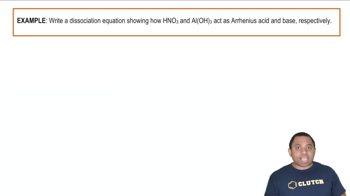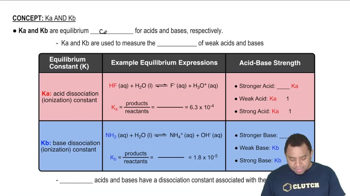Here are the essential concepts you must grasp in order to answer the question correctly.
Acid Dissociation
Acid dissociation refers to the process by which an acid donates a proton (H+) to a water molecule, resulting in the formation of a hydronium ion (H3O+). This process is fundamental in understanding the behavior of acids in aqueous solutions, as it determines the strength of the acid and its ability to increase the concentration of H3O+ in the solution.
Recommended video:
Acid-Base Dissociation Example
Ka Expression
The acid dissociation constant (Ka) is a quantitative measure of the strength of an acid in solution. It is defined as the ratio of the concentration of the products (hydronium ion and the conjugate base) to the concentration of the undissociated acid at equilibrium. The Ka expression provides insight into how readily an acid donates protons, with larger values indicating stronger acids.
Recommended video:
Characteristics of Ka and Kb
Chemical Equations
A chemical equation represents the reactants and products of a chemical reaction using their chemical formulas. In the context of acid dissociation, the equation illustrates how an acid, such as benzoic acid (C6H5COOH), dissociates in water to form hydronium ions and its conjugate base. Writing these equations correctly is essential for understanding the reaction dynamics and calculating related properties like pH.
Recommended video:
Balancing Chemical Equations
 Verified step by step guidance
Verified step by step guidance


